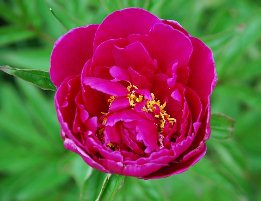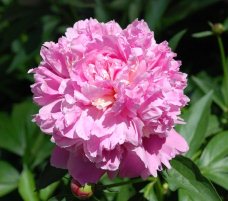Peonies, Paeonia lactiflora or Paeonia officinalis, are a favorite plant around Memorial Day. Many people use peony flowers to decorate the graves of their lost loved ones. This is a great flower to use because they typically bloom just prior to Memorial Day. They are wonderful additions to cemeteries because they come in so many colors and combinations of colors. Peony flowers may be single or double, which add a lot of variety to the many graves.
Most people are familiar with the traditional herbaceous perennials that grow to be 18-36 inches tall and wide. These plants have leaves that are divided into three, two times. Herbaceous peonies come up early in the spring as pink to burgundy colored spikes that grow quite rapidly in the warm weather of the spring. Peonies will bloom throughout May, depending on the variety or cultivar. Flowers come in all shades of white, pink, and red, with some yellows in hybrids. These flowers sometimes are a double bloom in one flower. The center of the flower and the stamens, or portions of the flower with the pollen on it, are usually a contrasting color. Because there are so many different varieties to choose from, it is hard to give a complete list.
In addition, there are two different species of peonies besides the basic hybrid peony. The fernleaf peony, Paeonia tenuifolia, is another herbaceous peony type with fern-like leaves that are deeply lobed and bloom early in the spring with deep red flowers. Fernleaf peonies grow slowly up to two feet tall.
Also, there is a tree peony, Paeonia suffruticosa, a woody shrub-like peony species. Tree peonies do not die back to the ground every year. They should not be cut back to the ground, because they will not grow back like the traditional peonies do.
Peonies have two main problems them - they get many ants all over their blooms and they tend to develop problems that cause a failure of blooming. The issue with the ants is minimal. The old wives' tale that ants are necessary for opening the bloom of a peony is not true. The ants are actually there because the peony flowers produce a great deal of sweet sap that the ants love to feed on. There is no way to cure this problem, just be sure to shake the flowers out before you bring them inside for decoration or you will have ants all over your kitchen or dining room. The most common problem that causes failure to bloom in peonies is that they were recently transplanted and they are now planted too deeply. Peonies must be transplanted to the same depth they were before; they are quite finicky about this.
As I mentioned, the most common use of peonies is as a floral decoration on a loved one's grave stone. Peonies have an amazing scent and wonderful coloration, so they also make a great cut flower. According to legends, peonies have been revered for centuries for the medicinal properties found in their roots. Many believe that peony roots can alleviate the pain of toothaches, childbirth, headaches, seizures, and much more. They are believed to help calm the nerves of irritable and anxious people. It's said to even possibly help treat dementia. Obviously, it wouldn't be wise to experiment with these medicinal properties on your own!
Peonies produce amazingly beautiful and sweet-smelling flowers. The different types have a wide range of colors and forms, including the tree peony and the fernleaf peony. There are many great uses for peonies, just make sure that you plant them at the correct depth or you may have to dig them up and lift them higher in the soil for blooms. Peonies are a great addition to any acreage or landscape. The next time you are looking for a wonderful spring blooming perennial, try peonies!



